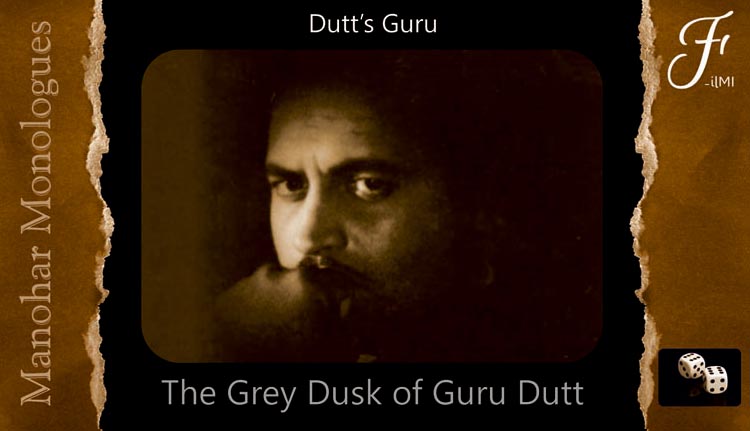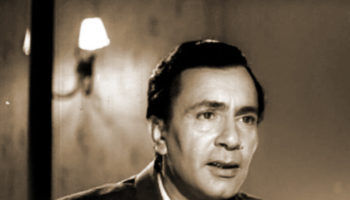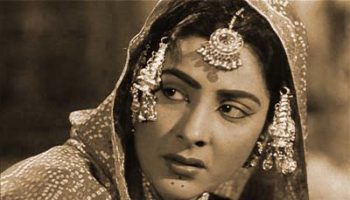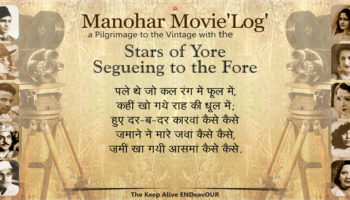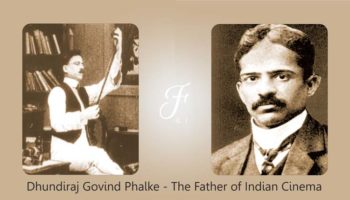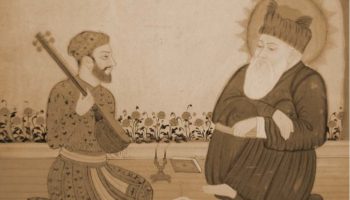Guru Dutt. The name itself is enough to connote how creative and creditable and what a celebrated and cerebrated genius he was.
This write up is MI sincere attempt to explore into the deep recesses of the mind of Guru Dutt: the director, the actor and the story teller and throw some light on the limited but creatively limitless body of work with an extensive world wide appeal. Dutt’s MI reverential tribute to MI cinema GuRu.
Here is a man who plumbed into the abyss of human emotions, made his audience dive into it to make them emerge with a chastened state of mind.
From Home to where HeArt is
Guru Dutt aka Vasant Padukone was the second of the six children born to intellectual, lower middle class Saraswat Brahmin parents on 09 July, 1925. The eldest one named Shashidhar died within six months of his birth due to severe bouts of fits. At the suggestion of the family priest Swami Ramdas at Anand Ashram, Mysore, Vasant’s name was changed to Gurudutt (not Guru Dutt); those born after him were Atmaram, Lalita, Devdas (later changed to Devi Dutt) and Vijay.
Gurudutt studied up to matric in Calcutta and because of his exposure and upbringing there, he imbibed the Bengali culture and custom and soon became Guru Dutt. The patronymic appendage ‘Dutt’ in his rechristened name Guru Dutt led people to believe that he was a Bengali and not a Konkani.
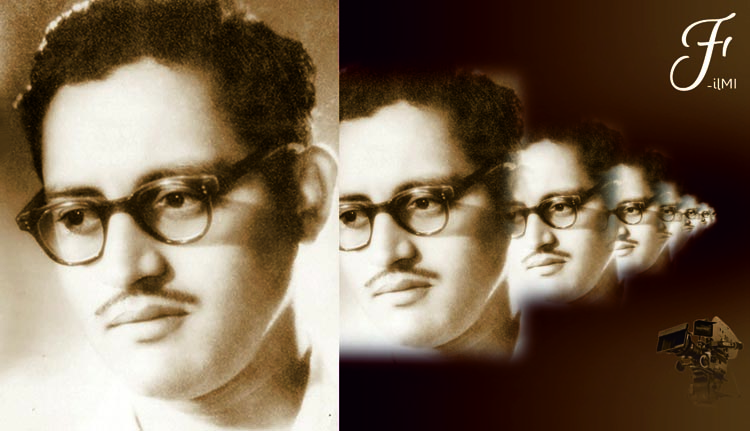
Guru Dutt was scholarly but not studious; he had an innate talent and creative mind and from childhood, he had a predilection for music, dance, drama and other forms of fine arts.
At the recommendation of his mother’s first cousin Sridhar Benegal (a still photographer and father of renowned filmmaker Shyam Benegal), he joined Uday Shankar’s dance academy in Almora in 1941 and worked there for four years. The academy closed in the mid 40s when the political situation in the country became more turbulent.
Thereafter, Guru Dutt had a brief stint as a telephone operator in Calcutta. To hone his artistic skills, he left the job and moved to Bombay. Again, with the help of a family friend, he joined the restructured Prabhat Films and worked as an assistant dance director besides doing a small role in an inconsequential film ‘Lakharani’ (1945) directed by Vishram Bedekar.
He then assisted Amiya Chakravarty in ‘Girls School’ (1949) and Gyan Mukherji in Bombay Talkies’ ‘Sangram’ (1950) though his name did not appear in the credit titles. Guru Dutt had the highest regards and respects for Gyan Mukherji and considered him as his Guru and mentor. For all the Gyan he imbibed from his Guru, Guru Dutt dedicated ‘Pyaasa’, his first in the series of classic films, to Gyan Mukherji. Dutt was the Guru~Gyan connect!
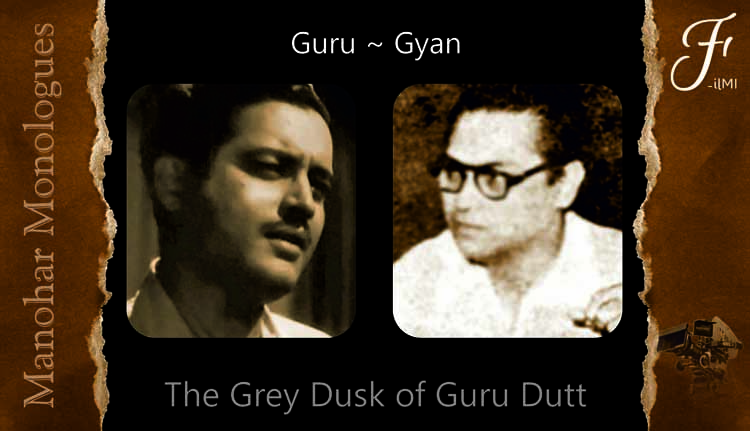
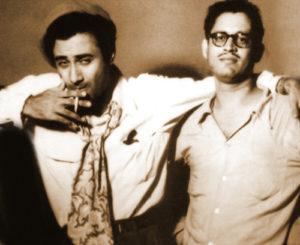 While working in Prabhat, the struggling duo Guru Dutt and Dev Anand, who made his debut as an actor in Prabhat’s ‘Hum Ek Hain’ (1946), became friends. During one of their interfaces, they entered into an unwritten agreement that the one who became successful first would give the other a break. And, as promised, Dev Anand, after having made a mark as a promising actor in over a dozen films, signed Guru Dutt to direct his second home production ‘Baazi’ (1951) made under his Navketan banner. The rest is a classic history!
While working in Prabhat, the struggling duo Guru Dutt and Dev Anand, who made his debut as an actor in Prabhat’s ‘Hum Ek Hain’ (1946), became friends. During one of their interfaces, they entered into an unwritten agreement that the one who became successful first would give the other a break. And, as promised, Dev Anand, after having made a mark as a promising actor in over a dozen films, signed Guru Dutt to direct his second home production ‘Baazi’ (1951) made under his Navketan banner. The rest is a classic history!
The Grey Dusk of Guru Dutt
Guru Dutt, with his inborn predilection towards darkness, took an affinity to embrace despair, devastation, despondency and dusky disdain, both literally and psychologically! On one hand, inspired by the noir films of Hollywood, he made shadowy crime thrillers replete with lyricism and romanticism. On the other hand, he carried forward this sensitive style of story~telling and made classic films which were self reflective and self portraits of a defeatist; suffused with subtlety and symbolism and imbued with dark poetry of the death wish! Dutt’s the way he was!!
Let’s take a peep into the Creative Pehlu of the Cosmic Persona that Guru Dutt was.
Baazi (1951)
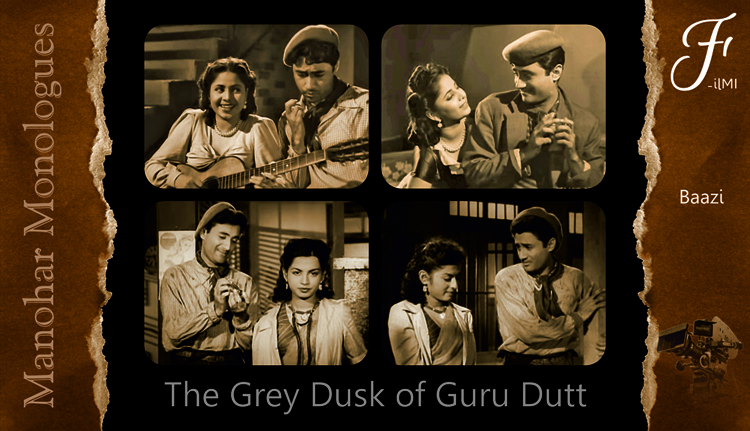
As per the unwritten promise made by Dev Anand and Guru Dutt, the former entrusted the responsibility of wielding the megaphone for ‘Baazi’ to Guru Dutt much against the wishes of his elder brother Chetan Anand. That was a big gamble which paid off in a bigger way!

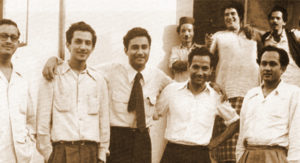 Soon after the country’s independence during the period of economic restructuring, several conscientious filmmakers like Amiya Chakravarty, Bimal Roy, Gyan Mukherji, Raj Kapoor, Zia Sarhadi shifted focus to films based on urban life and urban realities and portrayed what the city had to offer to the emerging youth: dreams, hopes, promises and opportunities on one hand and crime, felony, exploitation, lawlessness, sleaze and slums on the other hand. ‘Baazi’ was one such slickly made film with the crime backdrop. (Seen in the above picture are: Guru Dutt, Jal Mistry (Cinematographer), Dev Anand, Chetan Anand, Farukh Mistry (younger brother of cinematographers Jal and Fali Mistry) and standing behind are Bahadur, Syed Abu Baker nd Johnny Walker)
Soon after the country’s independence during the period of economic restructuring, several conscientious filmmakers like Amiya Chakravarty, Bimal Roy, Gyan Mukherji, Raj Kapoor, Zia Sarhadi shifted focus to films based on urban life and urban realities and portrayed what the city had to offer to the emerging youth: dreams, hopes, promises and opportunities on one hand and crime, felony, exploitation, lawlessness, sleaze and slums on the other hand. ‘Baazi’ was one such slickly made film with the crime backdrop. (Seen in the above picture are: Guru Dutt, Jal Mistry (Cinematographer), Dev Anand, Chetan Anand, Farukh Mistry (younger brother of cinematographers Jal and Fali Mistry) and standing behind are Bahadur, Syed Abu Baker nd Johnny Walker)
All the leading artistes, budding as well as known, who staked their careers in this film, won the ‘Guru Gamble’ and emerged winners:
Dev Anand, Geeta Bali, Kalpana Kartik, Geeta Roy, S D Burman, Sahir Ludhianvi, Raj Khosla and, not the least, Guru Dutt. 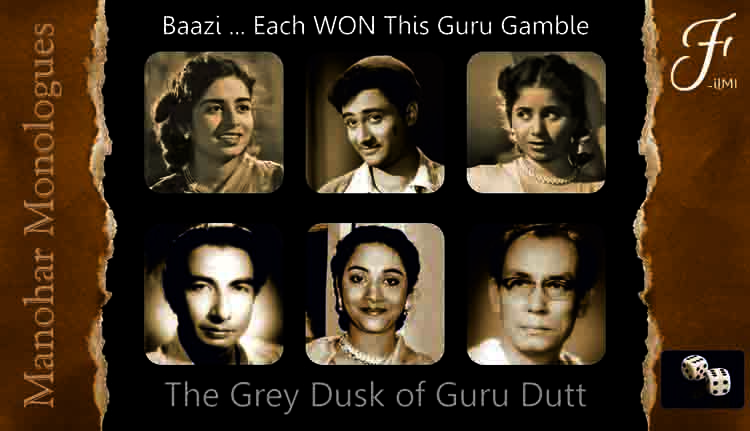
It is imperative and interesting to note that Guru Dutt gave Dev Anand a new image in the film. He cast his actor~friend as a cool and quick witted, confident and courageous, honest and holistic (even in the dishonest profession that he was in), smart and suave, small time gambler which suited his city bred, modern, urbane, dashing and debonair looks. This character gave a new definition, dimension and depth to crime, law and punishment.
On a closer observation, Guru Dutt’s ‘Baazi had lot of uncanny resemblance to his mentor Gyan Mukherji’s super hit crime thriller ‘Kismat’ (1943).
Let’s look at the Guru ~ Gyan Kismat Konnection:
*Both films were inspired by Hollywood noir films of the 40s;
Kismat was based loosely on Walter Wagner’s Algeirs;
Baazi was inspired by Gilda, borrowed bits from Destiny Rides Again, Casablanca.
*In Kismat, Ashok Kumar played a small time pickpocket;
In Baazi, Dev Anand played a small time gambler.
Both with almost same characteristics and traits as mentioned above: cool and quick witted, smart and suave etc.
*In Kismat, Ashok Kumar wears a head gear in the form of a turban throughout the film;
In Baazi, Dev Anand sports a cap.
Both continued the style in later year films.
*In Kismat, Ashok Kumar played the chivalrous paramour to his crippled beloved who worked (as a stage artiste) to support herself and her sister;
In Baazi, Dev Anand played the caring brother to his ailing sister who is treated with care and love by his beloved, a doctor.
*In Kismat, looking at the deftness of Ashok Kumar in pick pocketing, his sidekick V H Desai plants him for a major haul at a rich man’s place who turns out to be his long lost father;
In Baazi, Rashid Khan, impressed with the gambling prowess of Dev Anand, gets him a job in the casino of K N Singh who turns out to be the father of his beloved.
*In Kismat, Ashok Kumar’s name is Madan and also Shekhar as names of the characters are in most lost and found sagas;
In Baazi, Dev Anand’s name is Madan; and if you missed the name Shekhar, he was called by the name in Guru Dutt’s ‘C I D’.
*Both smoked incessantly, staked their honesty, integrity, character, morals and the self in entirety and emerged triumphant. More than many ways, Guru Dutt was a manifestation of his Guru.
*Even the titles ‘Kismat’ and ‘Baazi’ are so inter connected and inter related:
बाज़ी जीते या हारे, सब क़िस्मत के रहम पे है,
क़िस्मत साथ दे या न दे, बाज़ी हुनर के दम पे है.
So much for the Guru ~ Gyan connection!
From thereon, Dev Anand started building and cultivating an image suited to his persona. For the next three to four years, he was in a transitory mode:
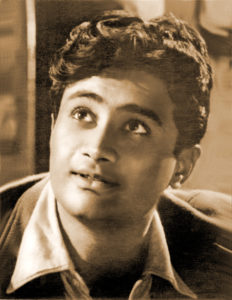 From the serious but not somber, sensitive but not self effacing, rather a self respecting and self oriented outlaw for whom duty and responsibilities took priority over love and romance, he started preparing himself for the the image of a carefree and casual, flirtatious and flamboyant lover for whom love and romance became more of a pastime. ‘Baazi’ set the base and gave way to a flamboyant and free wheeling image with a cutting edge of innocence.
From the serious but not somber, sensitive but not self effacing, rather a self respecting and self oriented outlaw for whom duty and responsibilities took priority over love and romance, he started preparing himself for the the image of a carefree and casual, flirtatious and flamboyant lover for whom love and romance became more of a pastime. ‘Baazi’ set the base and gave way to a flamboyant and free wheeling image with a cutting edge of innocence.
Ditto for the others who got a new identity and recognition with the success of the film:
Geeta Bali played an unconventional role, that of a club dancer with a crush on the hero, her partner in crime; the role was quite distinct from what she had done earlier in popular films like: ‘Badi Bahen’, ‘Dulari’, ‘Bawre Nain’ and ‘Albela’;
Kalpana Kartik, a distant relation of Chetan Anand’s wife, was introduced as the leading lady whom Dev Anand married three years later;
S D Burman became a composer of commercial reckoning and a mainstay in most of the films of Dev Anand made under his Navketan banner and even outside;
Geeta Roy, who had till then sung mostly sad and sentimental songs or devotional ditties, which typecast her as a bhajan singer, sang modern and westernised songs. The songs helped her break the bhajan singer image and in the years to come, she glided ‘roy’ally between the oriental and occidental with effortless ease;
Sahir Ludhianvi made a major breakthrough as a mainstream lyricist with his rebellious lines:
डरता है ज़माने की निगाहों से भला क्यों,
इंसाफ़ तेरे साथ है, इल्ज़ाम उठाले.
The success of the film and popularity of the songs crystallised the musical and lyrical bond between Sahir and S D Burman which lasted through about 20 films till ‘Pyaasa’ (1957), incidentally a film made by Guru Dutt.
Raj Khosla started as an assistant director and went on to direct ‘C I D’ (1956) for his Guru and also become one of the top most directors.
Some more ‘cards’ were at stake which soon became winning ‘trumps’ in the the years to come:
Johnny Walker, in a brief role of a drunkard, became an indispensable actor and factor in almost all Guru Dutt films;
K N Singh consolidated his position as a major villain with ‘Baazi’ as well as Raj Kapoor’s ‘Awara’ released in the same year with a strong message that criminals are not born, but made;
V K Murthy, who started as an assistant cameraman to the main cinematographer V Ratra, went on to become the favourite cameraman of Guru Dutt and created a special niche with his play of the light and shade;
Zohra Sehgal did some imaginative choreography, which in the later years, came to be known as ‘item’ songs;
Balraj Sahni wrote the screenplay and dialogues and shared the story credit with Guru Dutt. However, for many years, he had a hard time convincing people about his contribution to the film.
Guru Dutt proved himself as a consummate director and story teller with his very film. Another area in which he excelled himself was in the art and craft of song picturisation. In all his films, the music played a major role and the songs were integrated seamlessly in an imaginative and innovative manner. The lyrical style of story telling carried forward the narrative and held the viewers captive.
Particular mention is made of songs like Sharmaaye kaahe ghabraaye kaahe, Tadbeer se bigdi hui taqdeer banaale and Suno gajar kya gaaye. Incidentally, cupid struck Guru Dutt and during the recording of the song: ….. apne pe bharosa hai to ye dao lagaale, he duly staked his heart for Geeta Roy winning the ‘roy’al gamble in the bargain!! A new vasant emerged anew and Geeta Grahasti added grist and gravitas to Guru Gyan !!

‘Baazi’ worked wonders for each one associated with the film; each won the ‘Guru Gamble’ including Guru Dutt who, thereafter, became a safe bet at the box office. With one hit film under his belt, he became a force to reckon with, ranking along with marquee names, making a firm mark in the filmy firmament.
Whether the crime world or the film world or this maya nagri (Bombay then, Mumbai now), enticing with its maya jaal, there is only an entry, no exit! Guru Dutt, like many others, stayed on entrapped in this jaal of the glamour world and he was all set to direct his second film ironically titled ‘Jaal’.
Jaal (1952)

‘Jaal’ had almost the same team: Dev Anand, Geeta Bali, K N Singh, Johnny Walker, S D Burman, Sahir Ludhianvi, Geeta Roy, Raj Khosla with Guru Dutt at the helm of the jolly good roller coaster ride.
‘Jaal’ was inspired by an Italian film ‘Bitter Rice’. The film was set in the peaceful and scenic Goan backdrop with strong undertones of the Christian philosophy of forgiveness, love and peace and overtones of religious fervour:
 ना सुनो गर बुरा कहे कोई,
ना सुनो गर बुरा कहे कोई,
ना कहो गर बुरा कहे कोई;
रोकलो गर ग़लत चले कोई,
बख़्श दो गर ख़ता करे कोई.
Guru Dutt portrayed realistically the fisher folks belonging to the Christian community and avoided the stereotypes of showing them as drunkards and immoral. They are shown by and large as god fearing, industrious, peace loving and united. And at the same time they are free wheeling and fun loving type and celebrate, sing, dance and make merry without inhibitions. To one’s great relief, the characters don’t speak in the typical anglicised English but communicate in simple and understandable blend of Hindi and Urdu.
Dev Anand played the role of a gold smuggler, amoral, ambitious and avaricious to the core. He was unforgivably heartless and ruthless and shown as using his charms to con and convince, trick and trap, woo and win his two innocent, naive and vulnerable lady loves (Geeta Bali and Purnima) to assist him in his nefarious activities.

The apparently archetypical romantic songs: De bhi chuke hum dil nazrana and Ye raat ye chandni phir kahan mounted on a montage of their unique picturisation is subtly loaded with erotic overtones and seductive undercurrents to honey~trap the heroine.

While it was refreshing to see a mainstream hero with detestable dark and negative shades, the conservative audience loved to see the heroes and villains in clear black and white terms as representatives of the saint and satan respectively. Its for this very reason, the negative character of Dev Anand didn’t go down well with his admirers and the film failed to create magic at the box office.
Before embarking on his next film, Guru Dutt and Geeta Roy tied the knots on 26 May, 1953. And in the following ten years, they were blessed with three children (two sons and a daughter).
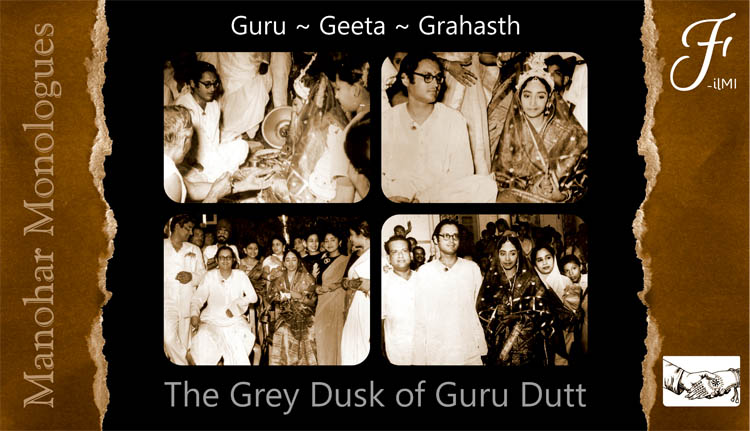
Baaz (1953)
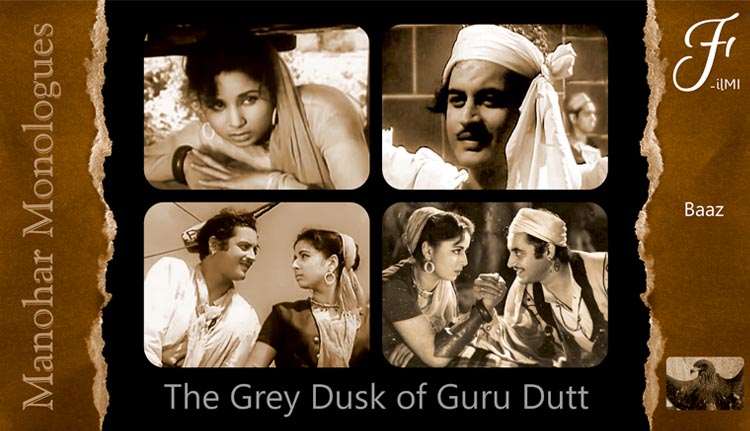
In the same year 1953, Guru Dutt co~produced a film with Geeta Bali’s sister Haridarshan Kaur. The film was ‘Baaz’, a high seas adventure film set in the backdrop of Portuguese liberation. He directed the film and also made his debut as an actor opposite Geeta Bali. The film sank without a trace and Guru Dutt was in severe debts; his credibility as an actor as well as director was at stake and he needed a hit to reassure his faith in himself and the audience as a filmmaker. He had to silence his critics who were quick to write him off. And pat came the ‘AR’tistic re’PAR’tee in the form of his own production house: he floated his now iconic Guru Dutt Films and the first film made under the banner was ‘Aar Paar’
Aar Paar (1954)
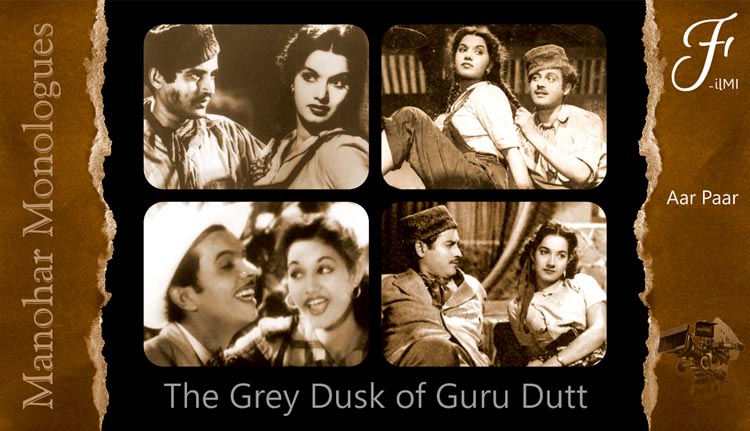
Inspired by the Hollywood film ‘Drive a Crooked Road’ starring Mickey Rooney, Guru Dutt started a quickie musical thriller titled ‘Aar Paar’ starring himself and Geeta Bali who later dropped out of the film following some misunderstanding between him and her sister. It is believed that even Shammi Kapoor was offered the lead role which he turned down for some reasons. Had he done the role, he would not have had to survive over a dozen flops and wait for another three more years till the release of Filmistan’s ‘Tumsa Nahin Dekha’ (1957) for his first major success.
As in all his films, ‘Aar Paar’ too had two heroines: Shyama and Shakila both of whom were yet to establish themselves though they had acted in a number of films. Guru Dutt too was relatively new as an actor and so were Johnny Walker, Jagdeep, Kumkum, Noor (sister of Shakila and whom Johnny Walker married later). Abrar Alvi too debuted as a writer with the film and pitched his loyalty to Guru Dutt till the end.
Music was by O P Nayyar who till then had a track record of three flop films and was yet to enter the list of successful composers. The only famous names associated with the film were: lyricist Majrooh Sultanpuri and the two lead singers Mohammed Rafi and Geeta Dutt.
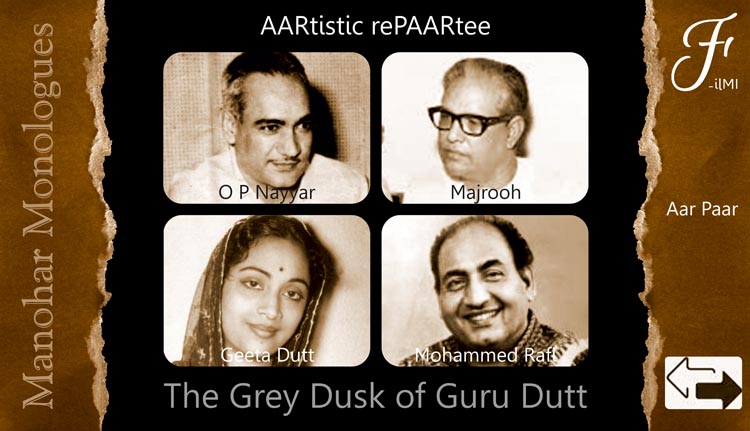
‘Aar Paar’ was a breezy musical thriller shot within a month through the length and breadth of the city of Bombay, the real star of the film.
All the songs became immensely popular and, except Babuji dheere chalna, the others were picturised on actual locations where the characters lived and not on unrealistic sets or ostentatious outdoor locations:
Ye lo main haari piya was shot on the ‘crowded’ roads of Bombay;
Kabhi aar kabhi paar was shot on an actual construction site;
Sunn sunn sunn sunn zaalima was picturised imaginatively inside a South Indian garage in Parel;
Hoon abhi main jawan was picturised in an old warehouse;
Na na na na tauba tauba was shot extensively in the Victoria Gardens, Byculla;
Mohabbat karlo jee bharlo by the Juhu beach side.

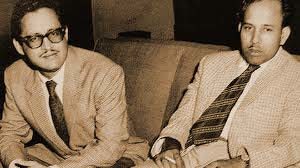 Another highlight of the film was the dialogues by Abrar Alvi. Generally, in films made in and around that time, a linguistic consistency in the dialogues spoken was maintained throughout the film which did not distinguish the characters clearly. But, in ‘Aar Paar’, the actors spoke in the dialect as per their characters and made the audience sit and take note of them:
Another highlight of the film was the dialogues by Abrar Alvi. Generally, in films made in and around that time, a linguistic consistency in the dialogues spoken was maintained throughout the film which did not distinguish the characters clearly. But, in ‘Aar Paar’, the actors spoke in the dialect as per their characters and made the audience sit and take note of them:
Guru Dutt played the role of a migrant taxi driver from Madhya Pradesh with a particular accent and extra stress on certain words;
Shyama and Shakila spoke normal Hindi;
Jagdish Sethi, the Punjabi garage owner, spoke with a typical Punjabi accent;
M A Latif, his Muslim soulmate, spoke in chaste Urdu;
Johnny Walker, a Parsi barman, spoke with the typical Parsi accent;
Jagdeep, as one of the street boys, spoke in the bambaiya Hindi.
‘Aar Paar’ made it in the big league! Like ‘Baazi’, even this film worked as a wonderment for all the artistes, setting them all on a firm footing. Backed by a ‘roy’al missus, the Mister was gung~ho once again, this time with something lissome and light hearted: Mr and Mrs 55!!
Mr and Mrs 55 (1955)
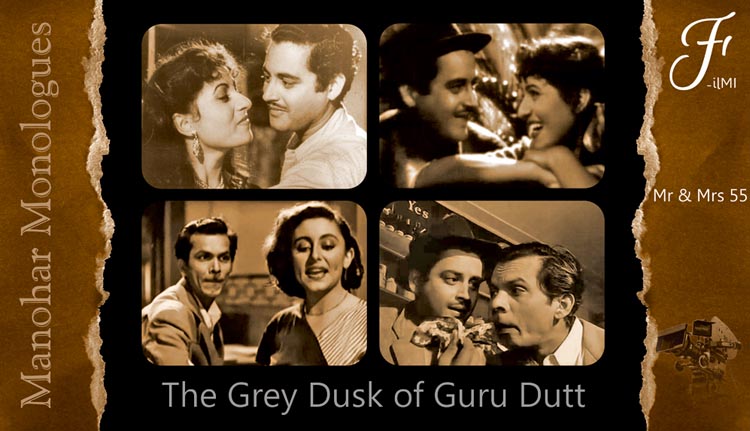
The romantic satire film was based on the play ‘Modern Marriage’ written by his trusted writer Abrar Alvi and inspired from the James Stewart ~ Hedy Lamarr’s American romantic comedy ‘Come Live With Me’. This film was all about a Vietnamese refugee who wants a US citizenship and who arranges a marriage of convenience with a struggling writer.
The title roles of ‘Mr and Mrs 55’ were played by Madhubala and Guru Dutt. The mesmerising magical beauty of Madhubala and the middle class disposition of Guru Dutt made them a ‘mismatch’ but their performances were absolutely matchless which silenced their detractors. The ‘other woman’ in the film was played by Lalita Pawar.

It was almost a comeback vehicle for Madhubala after a spate of flops. She played with great aplomb the role of an innocent and impetuous, naive and slightly foolish but lovable heiress to a huge property left by her father. Lalita Pawar played her feminist guardian who crusades and takes up for the women’s rights and liberation and ‘protects’ her niece from avaricious men eyeing for her wealth. Torn between the two women is Guru Dutt, who played an impoverished and struggling cartoonist, jobless and roofless which was the plight of several educated youth during the times of post independence economic restructuring.
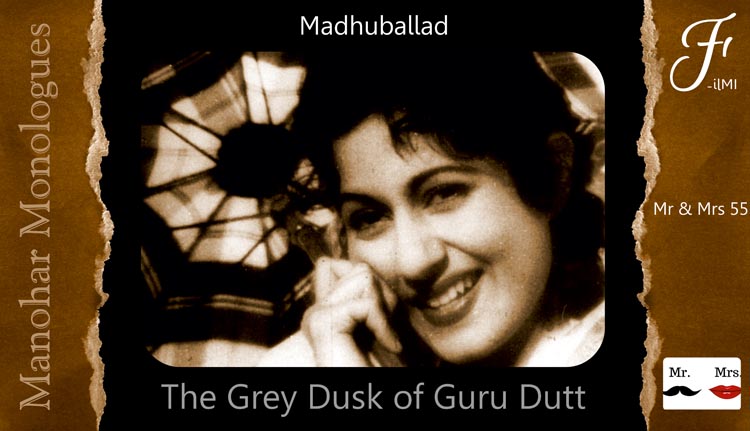
A marriage of convenience or a ‘conditional marriage’ is arranged between the lead pair which ultimately and predictably leads, through several hilarious situations, to their lifelong relationship as legally wedded couple .
Dialogues by Abrar Alvi were a delight alternating between Madhubala’s unwittingly childish, funny and even foolish one liners to Guru Dutt’s cynical, sarcastic and chauvinistic digs but in a harmless and innocuous way, subtle and straight faced. The radical and revolutionary thinking of the Ms Progressive Pawar were sprinkled with a liberal mix of angst and anxiety.
The repartee, rejoinders and retorts were laced with imagination and intelligence, puns and presence of mind, wits and wisecracks; at several situations, they diffused the highly charged and tense situations lending a wholesome light hearted feeling.
Music by O P Nayyar was effervescent and enlivened the tone and temper of the film. All the songs became very popular and particular mention is made of the unique pucturisation of fun filled song Jaane kahan mera jigar gaya ji on Johnny Walker and Noor inside an office room amidst chairs and tables.
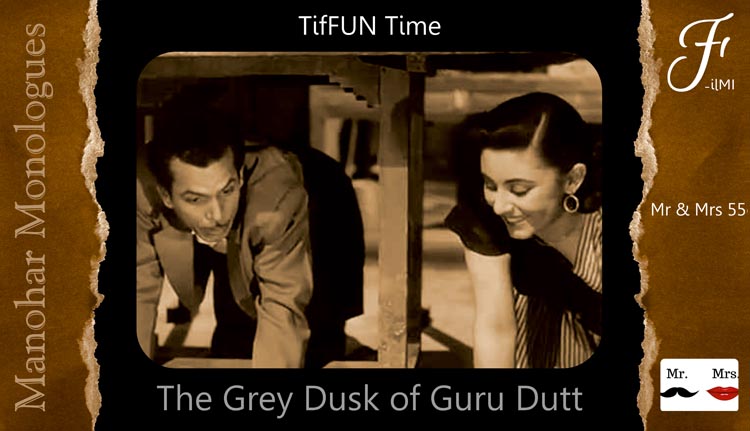
‘Mr and Mrs 55’ marked the humble beginning of the lyrical and poetic style of narration and presentation which became a leitmotif in his later years classics.
Creative Contrast
On a closer re~look, there is emphatically a great deal of similarity in the ‘creative’ characters played by Guru Dutt in ‘Mr and Mrs 55’, ‘Pyaasa’ and ‘Kaagaz Ke Phool’. Yet, each one was distinct, different and dimensional.
In all these cult~classics, on a micro~observation, we find that he plays a consummate artiste: a cartoonist, a poet, a filmmaker respectively, all depicting a cornucopia of creative class and clarity.
The differentiator in these characters are insofar as in ‘Mr and Mrs 55’, he is more practical and pragmatic, hiding his hurt and humiliation beneath a cynical smile and maintaining dignity even in desperation.
But in ‘Pyaasa’ and ‘Kaagaz Ke Phool’, the ‘reel’ and the ‘real’ get juxtaposed; he is more sober, serious, sensitive, self effacing and self depreciating. The pessimist in his natural self attains a larger than life proportion and the ‘reel’ character seeks morbid pleasure in embracing doom, despair and despondency as in the case of ‘real’ persona!!
The sharp contrast in the artistic tenor is better noticed when the discerning viewer finds that in ‘Mr and Mrs 55’, he sees his strength through the eyes of the cartoonist whereas, in the latter two films, the poet and the filmmaker sees the foibles and frailty through the eyes of his kith and kin and society at large.
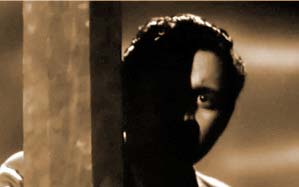 As always, the mesmerising and mystical camera work of V.K.Murthy and the lavish use of the light and shade enhanced the visual impact of many scenes and song sequences. He used the camera as a painter’s brush and his ‘drawings and paintings’ on the celluloid screen was a treat to the eyes. Particular mention is made of the climax song Meri duniya lutt rahi thi aur main khamosh tha where a brooding and pensive Guru Dutt is portrayed in half light in such a way that it sends a warning signal of something serious to occur. This intense scene gave a glimpse of the dark persona of Guru Dutt that one would see more in his classic films. Knowingly or unknowingly, this end scene marked an unintended beginning of the gradual end of the creative and cosmic persona.
As always, the mesmerising and mystical camera work of V.K.Murthy and the lavish use of the light and shade enhanced the visual impact of many scenes and song sequences. He used the camera as a painter’s brush and his ‘drawings and paintings’ on the celluloid screen was a treat to the eyes. Particular mention is made of the climax song Meri duniya lutt rahi thi aur main khamosh tha where a brooding and pensive Guru Dutt is portrayed in half light in such a way that it sends a warning signal of something serious to occur. This intense scene gave a glimpse of the dark persona of Guru Dutt that one would see more in his classic films. Knowingly or unknowingly, this end scene marked an unintended beginning of the gradual end of the creative and cosmic persona.
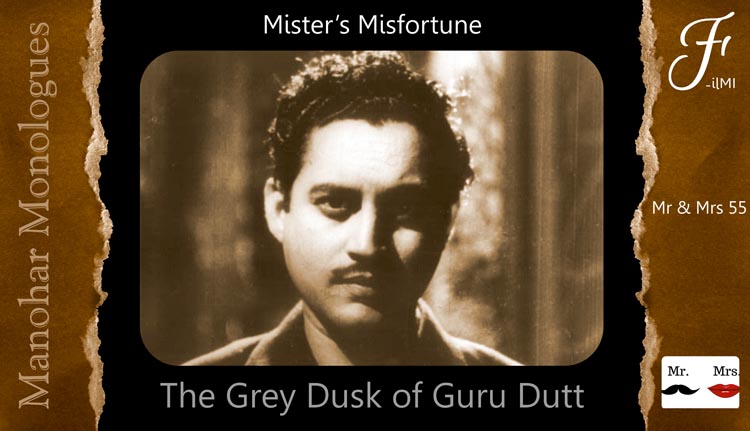
‘Mr and Mrs 55’ made their satirical presence in the year 1955 when the Hindu Marriage Act was passed and the box office pundits solemnised the ‘matchless mismatch’ without recourse to any police officer or C I D!
C I D (1956)
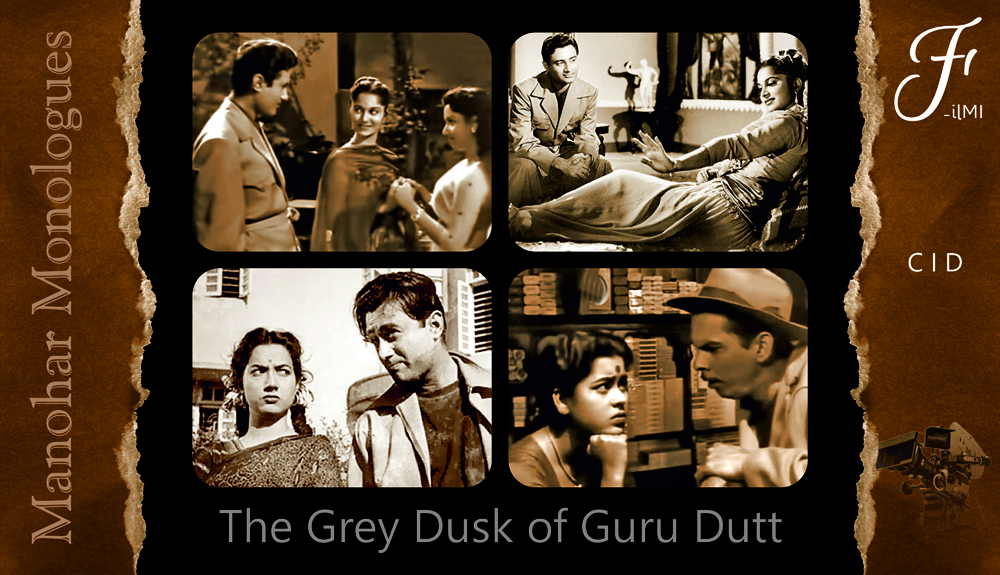
Dev Anand kept his promise and signed Guru Dutt to direct ‘Baazi’. As a reciprocation of the gesture, Guru Dutt signed the actor for his film ‘C I D’, a musical murder mystery with crime serving as the backdrop.
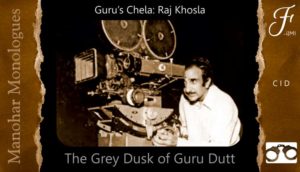 Guru Dutt entrusted the direction to his able assistant Raj Khosla who made his debut as an independent director a year before with the Dev Anand~Geeta Bali starrer ‘Milap’.
Guru Dutt entrusted the direction to his able assistant Raj Khosla who made his debut as an independent director a year before with the Dev Anand~Geeta Bali starrer ‘Milap’.
Music by O P Nayyar was a major highlight of this brisk paced crime thriller, particularly, the song written as an ode to the city of Bombay: Ae dil hai mushqil jeena yahan. To the initial and momentary disappointment of the movie goers, the year’s chart buster song was not on Dev Anand but on Johnny Walker who had thankfully, by then become a big star with a mandatory song in every film. Even the fleeting disappointment was gone.

For a change, Dev Anand played a law maker in the film and he was made to look serious. He had no song to sing and serenade his lady love played by Shakila who had played a vamp in the earlier film ‘Aar Paar’. Probably, he took his role more seriously!
The role of the ‘other woman’ was enacted by Waheeda Rehman who made her acting debut as a vamp. Like the ‘other woman’ or vampish characters in each of his earlier films, Waheeda too had a well defined role with multi layers to her character which could be a challenge to any actor, particularly a debutant. And she made a strong impact with her performance as well as seductive but not salacious dances in her very first film.

Like the other actresses who graduated from a vamp in one film to the lead heroine in the next, Waheeda Rehman too played the lead heroine in Guru Dutt’s next film ‘Pyaasa’. However, wittingly or unwittingly, she ended up being labelled as a vamp in his real life!
Pyaasa (1957)
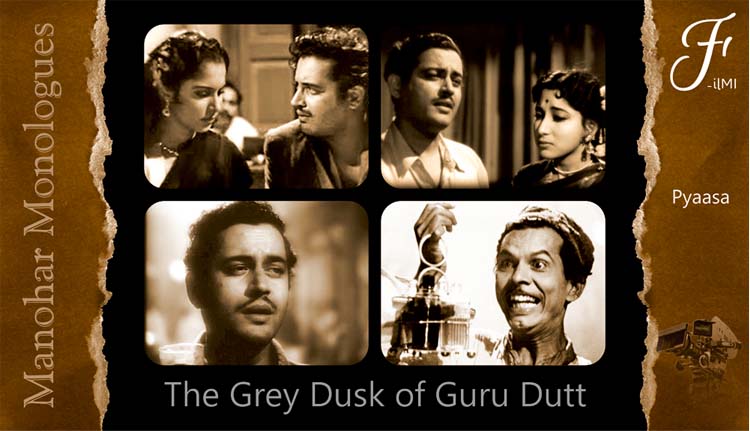
(What may be pyaasa~nating to note is I watched ‘Pyaasa’ (made up of pyaas + yaas + aas i.e desire and despair) 100 times during the erratically imposed lockdowns during the harrowing year 2020)
After four successful crime films and a comedy caper, Guru Dutt shifted focus to make some serious and seminal films which, over the years, came to be hailed as classics. The first in the series of the four classics was ‘Pyaasa’.
The story idea is believed to have originated in and around 1947 when he had just started and didn’t have much work. He started working on a story and titled it tentatively as ‘Kasmakash’. The story was based loosely on the character of a powerful and wealthy socialite woman of the Chetana Art Gallery in Kala Ghoda who patronised art and artistes for her own benefit. She would identify a promising talent, hone his skills, develop and build his career and then dump him for a newer one. It was out of his concern about the fate of such talented artistes (which did not exclude him) that he started working on the story which he gave up ultimately the moment he started assisting Amiya Chakravarty and Gyan Mukherji.
The story was revived in the mid 50s with the help of his writer friend Abrar Alvi. From ‘Kashmakash’ the title changed to ‘Pyas’ to connote the quest of the hero for name, fame and success and finally to ‘Pyaasa’ to connote the character.
As in his earlier (and future) films, ‘Pyaasa’ too had two heroines: Mala Sinha and Waheeda Rehman in two strikingly contrast roles.

Of the two, Mala Sinha had a more complex role with subtle negative shades which posed a great challenge to her at that phase of her career. She is ambitious, dreams big, craves for material comforts, looks for financial and social security; in the other words she is practical and rational. Nothing wrong. The role assumes complexity when she has the challenge of emoting and expressing the constant conscience struggle, as and when she is torn between the calculations of her head and calling of her heart.
Sadly, her role was relatively less talked about and the focus was more on the character of Gulabo, played by Waheeda Rehman. For two reasons: the ‘other woman’ had a more sympathetic and audience friendly role as a caring and compassionate street walker who is in empathy with the struggling poet and, more importantly, she was finding slowly a special place in the heart of the actor~filmmaker.
A lifetime role for any actor to play the ज़िन्दगी से हारा, मोहब्बत का मारा protagonist in ‘Pyaasa’, the inherent Kashmakash (Dutt’s dilemma) kept lingering in the mind of this creative czar. After toying with the idea of casting Dilip Kumar as the dejected and rejected poet, Guru Dutt himself played the role of Vijay, an impoverished and sensitive poet in search of unconditional and unalloyed love in this materialistic world. The central character with immense love and longing found that the world around is bereft of appreciation and, a true recognition for progressive poetry is a misnomer. The creative satisfaction, eternal contentment and spiritual fulfilment during his lifetime, hence remains elusive.

Vijay is a strong example of a weak character and his poetic sensibilities and sensitivities make him lament and lampoon at the decadent society, the deplorable social atrocities and cruelties, hypocrisy and falsity, where crass commercialisation and politicisation of art is the order of the day reflecting the moral decadence and degeneration of values.
As such, he finds himself out of sync with not only his kith and kin, friends and well wishers and his lady love, but also with the society at large.
Hapless and helpless, hurt and humiliated, he wallows in self pity, flounders under guilt for the atrocities of others and broods over his failed relationship and unrequited love. Unable to continue his sole fight, he gives up and gives expression to his agonising experiences in the form of his poetry laced with cynicism and social comment.
The film shakes the conscience and stirs the soul when one finds that his glory is sung and his poetic works are appreciated and rewarded posthumously and ironically in his presence after he is erroneously believed to be dead. Rehman, as the amoral, unscrupulous and conscienceless publisher played his part with conviction and convincingly.
An uncanny similarity can be seen in the reel life character of Guru Dutt and the real life filmmaker. In the film, the poet Vijay craves for appreciation and recognition for his poetry. Ditto in real life; Guru Dutt wanted to create a niche for himself as a filmmaker in the filmy world of formula ridden films. Both succeed but with a difference. The real life director succeeds and 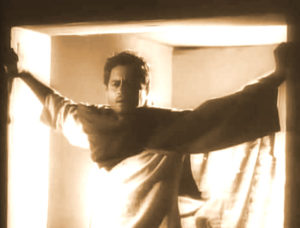 accepts his success with grace. The poet in the film too succeeds but stands in a crucifixion like pose at the portals of the worldly fame and his alter ego rejects all name, fame and glory which is bestowed upon him ‘after his death’ and reaches his epiphany with an outcry: ये दुनिया अगर मिल भी जाये तो क्या है?
accepts his success with grace. The poet in the film too succeeds but stands in a crucifixion like pose at the portals of the worldly fame and his alter ego rejects all name, fame and glory which is bestowed upon him ‘after his death’ and reaches his epiphany with an outcry: ये दुनिया अगर मिल भी जाये तो क्या है?
Music by S D Burman and lyrics by Sahir Ludhianvi contributed significantly to enhance the emotional quotient of the film and carry forward the narrative as also in the artistic and commercial success of the film.

Set in the backdrop of Calcutta, Guru Dutt wanted to picturise the songs in the city but had to make some cinematic compromises. In those days, it is believed that the Calcutta Municipal Corporation would give lot of trouble to Hindi filmmakers for giving permissions for shooting. Guru Dutt had entrusted the responsibility of location to a wrong person who was neither honest nor did he have knowledge of films. He would tell Guru Dutt that the required permissions were procured which, in reality, he never got putting Guru Dutt in an awkward and embarassing situation. And at every location, the unit was stopped by the Calcutta police.
It was then Guru Dutt decided to shoot songs in Central and Kardar Studios.
Aaj sajan mohe ang lagaalo, Hum aap ki ankhon mein were shot in Kardar studios, Parel;
Jaane kya toone kahi was shot completely at night on the banks of Hoogly River, Calcutta and patchwork done at Kardar Studios,
Jaane woh kaise log the in Central Studios, Tardeo;
Jinhen naaz hai hind parwoh kahan hain in Kardar Studios. Guru Dutt was refused permission to shoot in the red light area of Calcutta by the Prostitutes Association and they called police which caused further embarassments.
Peechhe peechhe duniya hai, the picnic duet by Mohammed Rafi and Geeta Dutt was shot in the Aarey Milk Colony but was deleted finally; only two lines were retained in the film
Rutt phire par din hamaare, a solo song by Geeta Dutt, was picturised at a location on the west side of Hoogly. This song too was deleted from the film.
Sar jo tera chakraye in Kardar Studios;
Ye duniya agar mil bhi jaaye to kya hai was the only song shot in Calcutta’s Town Hall but patch work of few shots were taken in Minerva Cinema, Bombay.
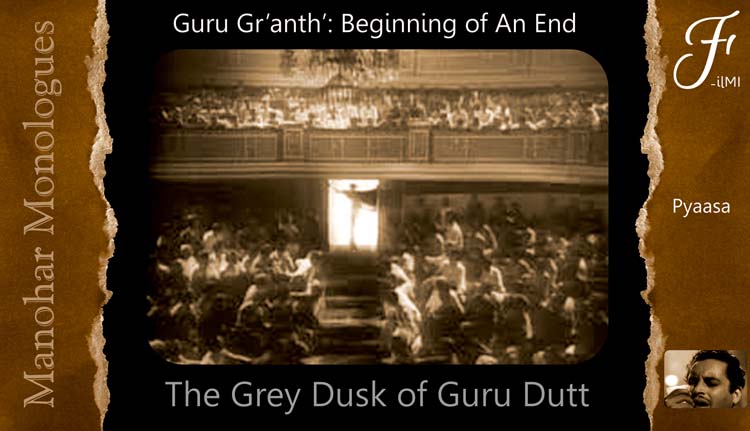
Each song was a musical gem, a lyrical masterpiece, a perfect synthesis of melody and poetry and both S D Burman and Sahir peaked their meridian with ‘Pyaasa’. Sadly, following ego clashes, the Burman~Sahir team which began with Guru Dutt’s crime thriller ‘Baazi’ ended with the filmmaker’s classic ‘Pyaasa’. A classic case of a musical crime!
S D Burman, with his limitations of understanding the nuances of Hindi~Urdu poetry, did full justice to the lyrics of Sahir by keeping the music subdued. He did not compose words and phrases but gave melodic expressions to the emotions and feelings infused there in by Sahir.
The romantic rebel poet looked for opportunities to arouse rebellious and fiery feelings even through film songs. And ‘Pyaasa’ offered him the fulsome freedom with absolute autonomy afforded by the auteur. His rebellious temperament revelled in making strong social and anti~establishment comments. Almost every song of ‘Pyaasa’, meaningfully set to tune in different musical genres, posed a question:
हम आपकी आंखों में इस दिल को बसादें तो?
सर जो तेरा चकराये…. काहे घबराये?
जाने क्या तूने कही?
जाने वो कैसे लोग थे जिनके प्यार को प्यार मिला?
जिन्हें नाज़ है हिंद पर वो कहां हैं?
ये दुनिया अगर मिल भी जाये तो क्या है?
The only answer is LOVE! But where does one get the fragrance of love in the paper flowers?
Kaagaz Ke Phool (1959)
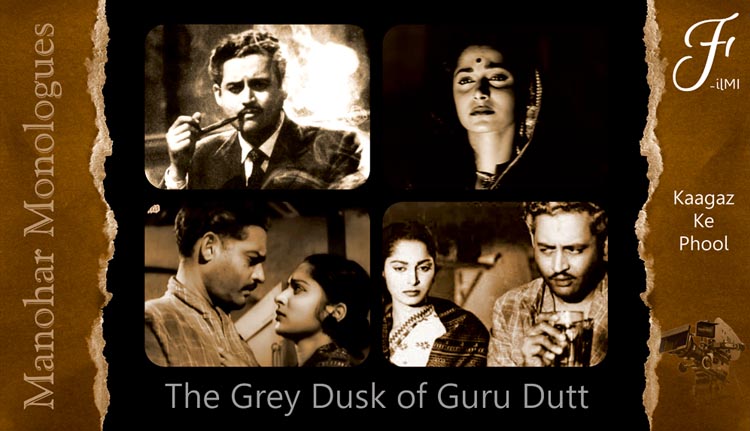
Heady with the artistic and commercial success of ‘Pyaasa’, Guru Dutt marched ahead and made another poignant film ‘Kaagaz Ke Phool’, exposing the artificiality and superficiality of the film line and hypocrisy and falsehood of emotions, feelings, relationship.
‘Kaagaz Ke Phool’ was semi autobiographical and portrayed the relationship between a famous filmmaker played by Guru Dutt and his protege, Waheeda Rehman. He is a married man with a family but estranged from his wife and in laws. The only reason to live is his young school going daughter who is studying in a boarding school. The film had a fair blend of facts and fiction and reflected the reel and real life tragedy of the actor~filmmaker.
Again, in this film too, the protagonist is torn between two women: his estranged wife (Veena in an inconsequential role) and his discovery Waheeda Rehman. By this stage of his career, Guru Dutt’s emotional involvement with Waheeda Rehman in real life was widespread, creating a divide chasm between Guru Dutt and his singer~wife Geeta Dutt and shattering the domestic bliss.

It would be interesting to note that in the film, Guru Dutt is shown to be drifting away from his wife and Waheeda Rehman, drawing close to him. In real life, the equation was more dramatic and heart wrenching; Guru Dutt was getting close to Waheeda Rehman and Geeta Dutt, drifting away from him. In both the cases, the ‘Guru’ of both the women was at the receiving end!
Adding fuel to fire was the film flopping miserably at the box office; the reason being the film was quite abstract and of an intellectual level, beyond the comprehension of the lay man. The box office failure entailed him in huge financial losses and, as depicted in the film, Guru Dutt decided not to direct any more films and took to drinking. A case of fiction becoming factual and reel life tragedy becoming real life tragedy.

‘Kaagaz Ke Phool,’ had music by S D Burman and lyrics by Kaifi Azmi and two outstanding scores stand out: Bichhde sabhi baari baari and Waqt ne kiya kya haseen sitam.
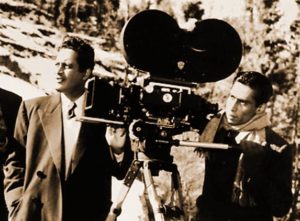 The film is noteworthy for its brilliant cinematography by V K Murthy and his highly imaginative use of light and shade particularly in the song Waqt ne kiya kya haseen sitam is hailed as a benchmark in cinematographic excellence. In the song, though the union of physicality of the two actors was more adrift, Murthy depicted movingly their spirit of mutuality moving and merging into higher spirit of communion.
The film is noteworthy for its brilliant cinematography by V K Murthy and his highly imaginative use of light and shade particularly in the song Waqt ne kiya kya haseen sitam is hailed as a benchmark in cinematographic excellence. In the song, though the union of physicality of the two actors was more adrift, Murthy depicted movingly their spirit of mutuality moving and merging into higher spirit of communion.
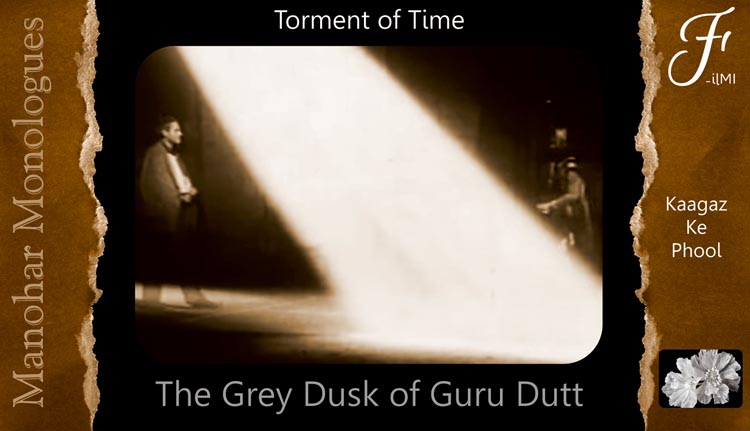
Truly, Time played Truant and Guru Dutt was not the same again. The sun had set but the moon refused to rise and shine!
Chaudvin Ka Chand (1960)
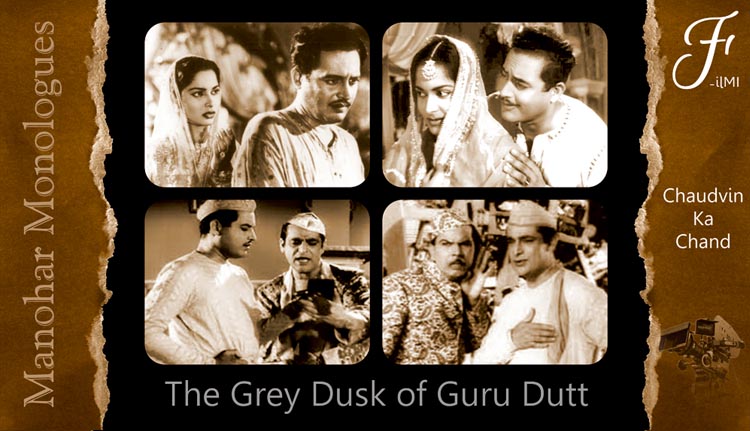
To resurrect his banner from the financial setback it suffered, Guru Dutt made a Muslim social ‘Chaudvin Ka Chand’ on friendship, love and sacrifice.
The conservative and secular upbringing of Guru Dutt gets a grand resonance and reflection in each and every deportment of his life and letters and finds him fraternising with members across inter~community linkges and most prominently with people subscribing to the Islamic faith. His personal and professional bonding ranged from his cook Ismail and drivers Abdul and Mehmood to his dialogue writers~directors Abrar Alvi, M Sadiq and Shahid Latif; his lyrics writers Kaifi Azmi, Majrooh, Sahir and Shakeel; his actors ranging from Anwari, Naaz, Noor, Kumkum, Minoo Mumtaz, Mumtaz Begum, Noor, Uma Devi, Yasmin and Zebunisa to Al Nasir, Nazir Husain, Rashid Khan, Rehman and Johny Walker to Madhubala, Meena Kumari, Purnima, Shyama, Shakila, Veena and Waheeda Rehman!
Guru Dutt entrusted the direction of ‘Chaudvin Ka Chand’ to M Sadiq who had a special knack for directing Muslim subjects. For a change, there was nothing self reflective or self indulgent though it did have some morbid moments. Music direction was given to Ravi, to upkeep the promise Guru Dutt had made to him after listening to his impressive score in ‘Mehndi’. The film’s title song, picturised in colour and sung by Mohammed Rafi was at the top of the charts that year.

‘Chaudvin Ka Chand’ was a big hit at the box office and saved the banner from crumbling but who could save the edifice of domestic bliss and bonding between the Sahib and Bibi from disintegrating further and falling to pieces!
Sahib Bibi aur Ghulam (1962)
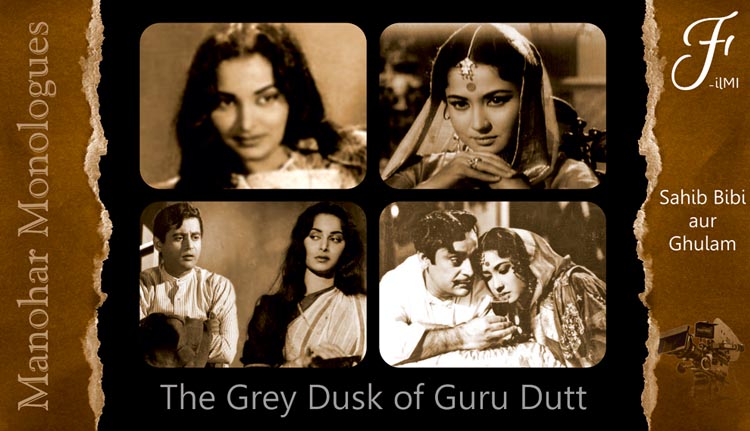
The fourth and last classic that Guru Dutt made was ‘Sahib Bibi aur Ghulam’ based on Bimal Mitra’s Bengali novel by the same name.
The film was a stark comment on Bengal’s decaying feudal system and decadent lifestyle of the zamindars and was set in the pre independent colonial Calcutta.
Guru Dutt entrusted the direction to his writer friend Abrar Alvi though it is believed that he ‘ghost directed’ the film. The picturisation of songs was however done by Guru Dutt.
The titles roles were portrayed by Rehman, Meena Kumari and Guru Dutt respectively. In this film too, as in his earlier films (and real life), the character of Bhootnath played by Guru Dutt was torn between two women: the chhoti bahu Meena Kumari and the ‘other woman’, Waheeda Rehman though she had not anything challenging to do in the film. In fact, it is said that the role was created specially for her.
The heart and soul of the film was Meena Kumari. She is an ethereal beauty, a goddess who cannot be reached and attained and one glimpse of hers makes Bhootnath her ghulam forever. The platonic relationship between them has been presented with great dignity and restraint.

The chhoti bahu has everything one could dream of except the love of her morally corrupt and debauch zamindar husband. She is ready to go to any extent to draw his attention and crave his indulgence. She oversteps the limits set by the conservative society she lives in, takes to drinking, throws enticing glances at him, swings her hair and flings herself at his feet, slurs, sings and seduces him, only to win his love and meet her carnal desires.

Keeping in mind the Bengali milieu, music direction was entrusted to Hemant Kumar who collaborated with Shakeel Badayuni for the lyrics. The songs filmed on Meena Kumari were rendered by Geeta Dutt and those on Waheeda Rehman by Asha Bhosle including a mujra on another actress (Minoo Mumtaz) which was shot in an incredibly imaginative way by V K Murthy using the time tested play of light and shade.
There was yet another song ‘Saahil ki taraf kashti le chal, toofan ke thapede sehna kya‘ sung by Hemant Kumar himself. The song picturised towards the climax of the film where the ‘chhoti bahu’is shown resting on the lap of Bhootnath was edited out of the film. The unused composition (may be with some minor changes in the notes) was used again by Hemant Kumar with fresh lyrics (Ya dil ki suno duniyawalo, ya mujhko abhi chup rehne do) by Kaifi Azmi for a poetic situation in Hrishikesh Mukherji’s sensitive film ‘Anupama”.
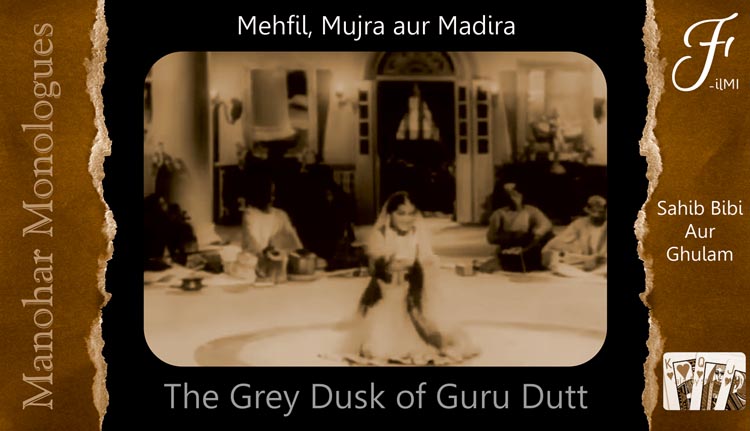
Though the film won several awards, the box office collections weren’t as rewarding. ‘Sahib Bibi air Ghulam’ virtually marked the end of Guru Dutt’s career as a creative filmmaker. It also marked the end of his ‘seven year itch’ with Waheeda Rehman.
In a short but illustrious career spanning about fifteen years, Guru Dutt made the above mentioned highly acclaimed crime based, comic satire and classic films. All these films, except ‘Baazi’, ‘Jaal’ and ‘Baaz’ were made under his banner Guru Dutt Films. Besides acting in most of his films, he acted in a few outside banner films too like: ‘Sailaab’ (which he directed too for his brother in law Mukul Roy who gave the music too), ’12 O’Clock’ (directed by Pramod Chakravarty, whose wife Laxmi was the sister of Geeta Dutt), ‘Sautela Bhai’, ‘Bharosa’, ‘Bahu Rani’, ‘Saanjh aur Savera’ and ‘Suhagan’ (most of them belonging to south filmmakers).
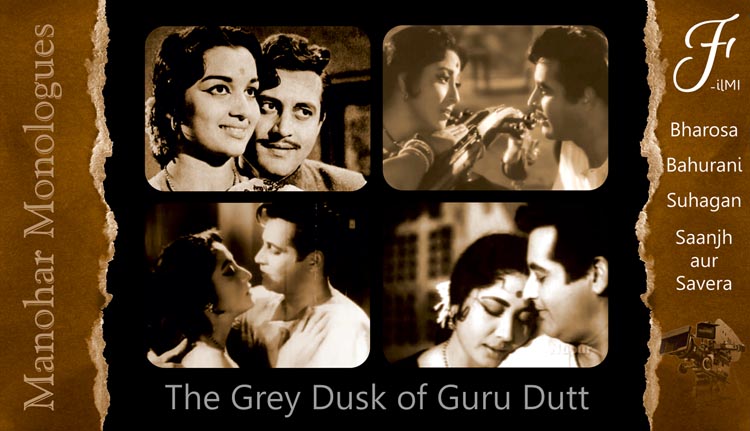
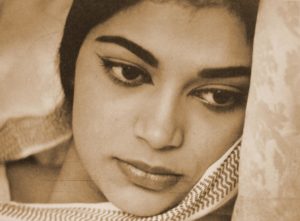 Guru Dutt did these south banner films of the 60s only for financing his colour film titled ‘Kaneez‘ which he was contemplating then with Simi in the lead and which was shelved. Likewise, he planned and / or started several other films and shelved them: ‘Gouri‘ (in Bengali with Geeta Dutt in the title role), ‘Motu Ki Mousi‘ (with himself along with Tanuja, Johnny Walker, Mehmood, Dhumal and Helen and to be directed by younger brother Atmaram) and ‘Raaz‘ (all in the late 50s).
Guru Dutt did these south banner films of the 60s only for financing his colour film titled ‘Kaneez‘ which he was contemplating then with Simi in the lead and which was shelved. Likewise, he planned and / or started several other films and shelved them: ‘Gouri‘ (in Bengali with Geeta Dutt in the title role), ‘Motu Ki Mousi‘ (with himself along with Tanuja, Johnny Walker, Mehmood, Dhumal and Helen and to be directed by younger brother Atmaram) and ‘Raaz‘ (all in the late 50s).
Incidentally, ‘Raaz’ was made later as ‘Woh Kaun Thi’ by Raj Khosla. Interestingly, had ‘Raaz’ been made, it would have marked the debut film of R D Burman as a composer. He had recorded two songs written by Shailendra; one of them worded Tum meri zindagi mein kuch is tarah se aaye in the voices of Hemant Kumar and Geeta Dutt. As the film didn’t get made, R D Burman recorded the sang almost a decade later for the Amitabh Bachchan starrer ‘Bombay to Goa’ in the voices of Kishore Kumar and Lata Mangeshkar. Even this song did not find a place in the film. Dutt’s what is called a jinx!
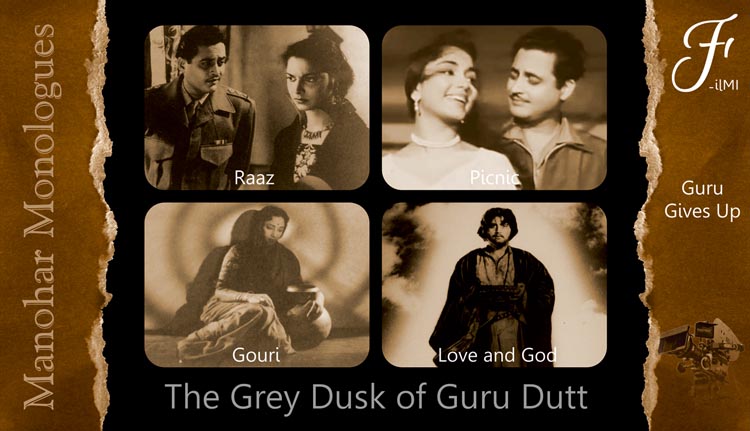
A few more films of the 60s which he planned and shelved and / or left incomplete at different stages include:
‘Ek Tuku Chau‘ in Bengali with Geeta Dutt;
‘Bees Saal Baad‘: Guru Dutt gave away the rights to Hemant Kumar along with his art director Biren Nag and Waheeda Rehman who was still under a contract with Guru Dutt Films. Finally, Biren Nag directed the film made by Hemant Kumar under his banner Gitanjali Pictures with Waheeda Rehman and Biswajit in the lead;
‘Professor‘: Likewise, Guru Dutt sold the rights of the film to be made with Kishore Kumar and Waheeda Rehman and directed by his assistant Shyam Kapoor to F C Mehra who then made the film with Shammi Kapoor and Kalpana;
‘Neel Kamal‘ with Mala Sinha and Waheeda Rehman;
‘Baharen Phir Bhi Aayengi‘: Guru Dutt even shot almost ten reels and gave up the idea of facing the camera and directing it. For the picturisation of the song Aap ke haseen rukh pe aaj naya noor hai, it is reported that Guru Dutt gave a whopping sum of Rs. 25,000 to his trusted cameraman V K Murthy and instructed him to shoot it the way he wanted. The latter is believed to have said that this was the last amount that he received from his sensitive friend.
After Guru Dutt died leaving the film incomplete, no other actor was willing to replace him. His younger brother Atmaram had taken over the responsibility of completing the film with Shahid Latif as the director. The role of Guru Dutt was done finally by Dharmenda who, when asked about the remuneration, charged a pittance (Rs. 1.25 only). Later, when Atmaram approached Dharmendra for his film ‘Shikar’, Dharmendra is believed to have told him smilingly, “That film was for my Guruji but for this film (i.e. Shikar) you must pay me my market price”!
‘Picnic‘ opposite Sadhana; a few scenes and songs to were filmed on the two.
‘Love and God‘, K Asif’s yet another ambitious magnum opus opposite Nimmi.

To paraphrase the Creative Pehlu of the Cosmic Persona‘, after a spate of commercially successful and creatively satisfying films like ‘Baazi’, ‘Jaal’ ‘Aar Paar’, ‘Mr and Mrs 55, C I D’, ‘Pyaasa’, came the life shattering failure in the form of ‘Kaagaz Ke Phool’, a semi autobiographical film, close to his heart, which marked the beginning of his end!
His ever increasing emotional involvement with his discovery and protégé Waheeda Rehman (after which pessimism crept into his life and films); the resultant upheavals in the domestic bliss; the ever widening distance between Geeta and Guru; the box office debacle of ‘Kaagaz Ke Phool’ and the financial mess it landed him in; the last nail in the coffin in the form of ‘Sahib Bibi aur Ghulam’, his fatal fall as a commercial filmmaker and the heart breaking break up with Waheeda Rehman tantamount to his life becoming a suicide note! But, Dutt’s the way he was: a picture of doom and despair. And this, MI humble tribute to my GuRu!
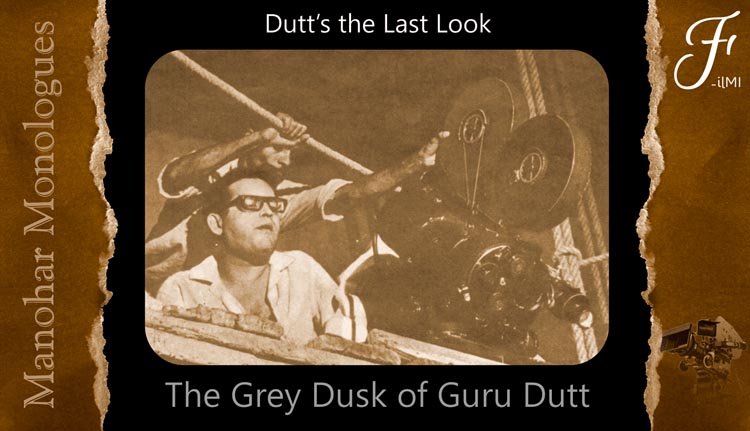
Photo as published in the Filmfare issue dated 02 October 1964 (a week before he died)
Incidentally, ‘Gu’ means ‘darkness’; ‘Ru’, ‘one who dispels darkness’. The two sylabbles word connotes ‘from darkness on to light’! But the life and career of this GuRu saw an unique roundabout turn from a luminous life embracing the gravity of darkness ! The ‘darkness’ (i.e ‘Gu’) that he is seen embracing depicts the ‘Ru’ dispelling, ironically, the light of his life; totally obliterating the ‘Vasant’ of a seasoned career; marking the beginning of a sudden end; terminating the zenith of a zany career to zilch !!!
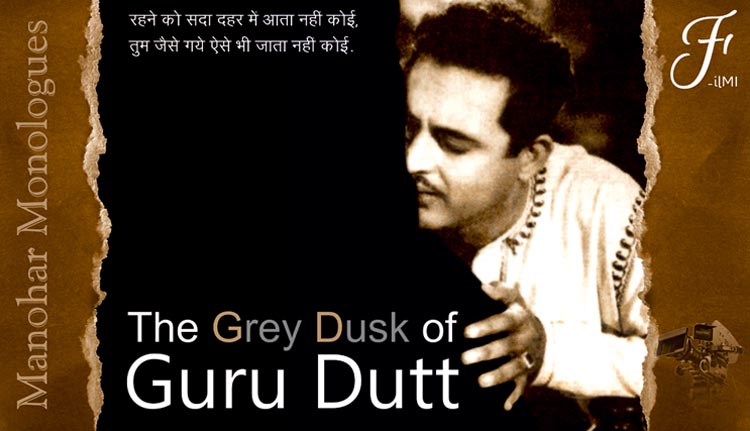
The truism of his sudden and shocking end finds expression in the poignant lines of the renowned poet Kaifi Azmi:
रहने को सदा दहर में आता नहीं कोई,
तुम जैसे गए, ऐसे भी जाता नहीं कोई।
डरता हूं कहीं ख़ुश्क न हो जाये समंदर,
राख़ अपनी कभी आप बहाता नहीं कोई।
इक बार तो ख़ुद मौत भी घबरा गयी होगी,
यूं मौत को सीने से लगाता नहीं कोई।
माना कि उजालों ने तुम्हें दाग़ दिये थे,
बेरात ढले शम्मा बुझाता नहीं कोई।
साक़ी से गीला था तुम्हें मैख़ाने से शिकवा,
अब ज़हर से भी प्यास बुझाता नहीं कोई।
हर सुबह हिला देता था ज़ंजीर ज़माना,
क्यों आज दीवाने को जगाता नहीं कोई।
अर्थी तो उठा लेते हैं सब अश्क बहा के,
नाज़~ए~दिल ए बेताब उठाता नहीं कोई।
*Manohar ‘Mohabbat’ Iyer*

